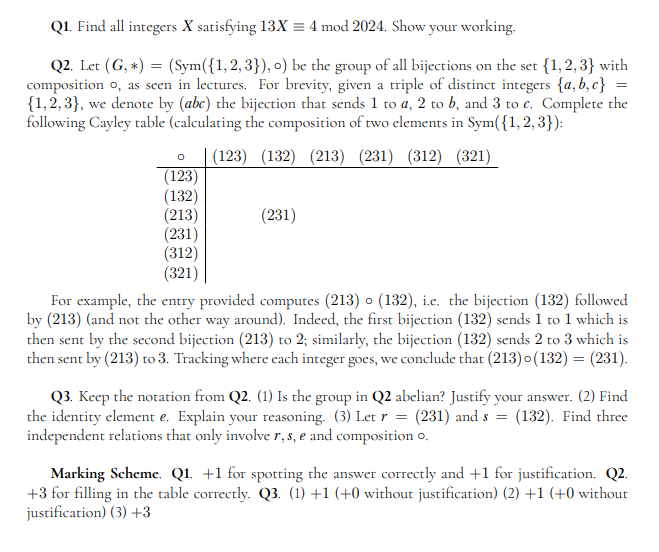Q1. Find all integers X satisfying 13X = 4 mod 2024. Show your working. = Q2. Let (G, *) = (Sym({1,2,3}), o) be the group of all bijections on the set {1,2,3} with composition o, as seen in lectures. For brevity, given a triple of distinct integers {a,b,c} {1,2,3}, we denote by (abc) the bijection that sends 1 to a, 2 to b, and 3 to c. Complete the following Cayley table (calculating the composition of two elements in Sym({1, 2, 3}): (123) (132) (213) (231) (312) (321) O (123) (132) (213) (231) (312) (321) (231) For example, the entry provided computes (213) o (132), i.e. the bijection (132) followed by (213) (and not the other way around). Indeed, the first bijection (132) sends 1 to 1 which is then sent by the second bijection (213) to 2; similarly, the bijection (132) sends 2 to 3 which is then sent by (213) to 3. Tracking where each integer goes, we conclude that (213)o(132) = (231). Q3. Keep the notation from Q2. (1) Is the group in Q2 abelian? Justify your answer. (2) Find the identity element e. Explain your reasoning. (3) Let r = (231) and s = (132). Find three independent relations that only involve r, s, e and composition o. Marking Scheme. Q1 +1 for spotting the answer correctly and +1 for justification. Q2. +3 for filling in the table correctly. Q3. (1) +1 (+0 without justification) (2) +1 (+0 without justification) (3) +3
Q1. Find all integers X satisfying 13X = 4 mod 2024. Show your working. = Q2. Let (G, *) = (Sym({1,2,3}), o) be the group of all bijections on the set {1,2,3} with composition o, as seen in lectures. For brevity, given a triple of distinct integers {a,b,c} {1,2,3}, we denote by (abc) the bijection that sends 1 to a, 2 to b, and 3 to c. Complete the following Cayley table (calculating the composition of two elements in Sym({1, 2, 3}): (123) (132) (213) (231) (312) (321) O (123) (132) (213) (231) (312) (321) (231) For example, the entry provided computes (213) o (132), i.e. the bijection (132) followed by (213) (and not the other way around). Indeed, the first bijection (132) sends 1 to 1 which is then sent by the second bijection (213) to 2; similarly, the bijection (132) sends 2 to 3 which is then sent by (213) to 3. Tracking where each integer goes, we conclude that (213)o(132) = (231). Q3. Keep the notation from Q2. (1) Is the group in Q2 abelian? Justify your answer. (2) Find the identity element e. Explain your reasoning. (3) Let r = (231) and s = (132). Find three independent relations that only involve r, s, e and composition o. Marking Scheme. Q1 +1 for spotting the answer correctly and +1 for justification. Q2. +3 for filling in the table correctly. Q3. (1) +1 (+0 without justification) (2) +1 (+0 without justification) (3) +3
Elements Of Modern Algebra
8th Edition
ISBN:9781285463230
Author:Gilbert, Linda, Jimmie
Publisher:Gilbert, Linda, Jimmie
Chapter3: Groups
Section3.4: Cyclic Groups
Problem 27E
Related questions
Question
answer this three question thx!

Transcribed Image Text:Q1. Find all integers X satisfying 13X = 4 mod 2024. Show your working.
=
Q2. Let (G, *) = (Sym({1,2,3}), o) be the group of all bijections on the set {1,2,3} with
composition o, as seen in lectures. For brevity, given a triple of distinct integers {a,b,c}
{1,2,3}, we denote by (abc) the bijection that sends 1 to a, 2 to b, and 3 to c. Complete the
following Cayley table (calculating the composition of two elements in Sym({1, 2, 3}):
(123) (132) (213) (231) (312) (321)
O
(123)
(132)
(213)
(231)
(312)
(321)
(231)
For example, the entry provided computes (213) o (132), i.e. the bijection (132) followed
by (213) (and not the other way around). Indeed, the first bijection (132) sends 1 to 1 which is
then sent by the second bijection (213) to 2; similarly, the bijection (132) sends 2 to 3 which is
then sent by (213) to 3. Tracking where each integer goes, we conclude that (213)o(132) = (231).
Q3. Keep the notation from Q2. (1) Is the group in Q2 abelian? Justify your answer. (2) Find
the identity element e. Explain your reasoning. (3) Let r = (231) and s = (132). Find three
independent relations that only involve r, s, e and composition o.
Marking Scheme. Q1 +1 for spotting the answer correctly and +1 for justification. Q2.
+3 for filling in the table correctly. Q3. (1) +1 (+0 without justification) (2) +1 (+0 without
justification) (3) +3
Expert Solution
This question has been solved!
Explore an expertly crafted, step-by-step solution for a thorough understanding of key concepts.
Step by step
Solved in 1 steps with 2 images

Recommended textbooks for you

Elements Of Modern Algebra
Algebra
ISBN:
9781285463230
Author:
Gilbert, Linda, Jimmie
Publisher:
Cengage Learning,

Linear Algebra: A Modern Introduction
Algebra
ISBN:
9781285463247
Author:
David Poole
Publisher:
Cengage Learning

Elements Of Modern Algebra
Algebra
ISBN:
9781285463230
Author:
Gilbert, Linda, Jimmie
Publisher:
Cengage Learning,

Linear Algebra: A Modern Introduction
Algebra
ISBN:
9781285463247
Author:
David Poole
Publisher:
Cengage Learning